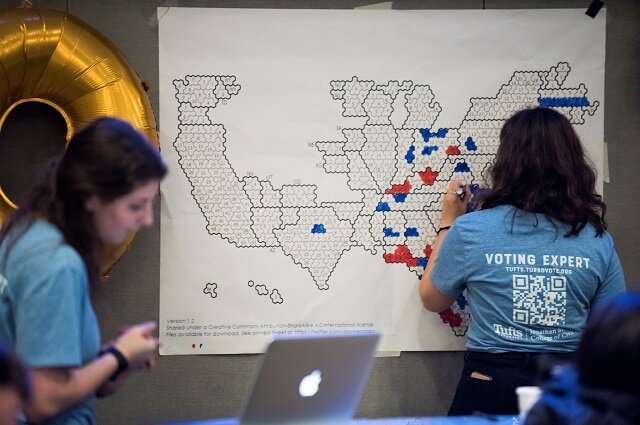Tufts University students fill in a map of Congressional districts on the night of the 2018 midterms. Election Day 2018 marked a watershed for college student voting. Credit: Alonso Nichols, Tufts University
College-student voting rates in the 2018 midterm elections doubled compared to the 2014 midterms, marking a watershed election year for student voter turnout, according to a report today from the Institute for Democracy & Higher Education (IDHE) at Tufts University's Tisch College of Civic Life. The report, Democracy Counts 2018, is based on an analysis of the voting patterns of more than 10 million college students on more than 1,000 campuses participating in the National Study of Learning, Voting, and Engagement (NSLVE).
In 2018, the Average Institutional Voting Rate (AIVR) among campuses in the study was 39.1 percent, nearly 20 percentage points higher than 2014's average turnout rate of 19.7 percent. Turnout increases were widespread, with virtually all campuses seeing an increase over 2014.
Major research findings include:
- In the 2018 midterm elections, college students turned out to vote at double the rate of the last midterm. Across all students in the study, the National Student Voting Rate (NSVR) in 2018 was 40.3 percent. Remarkably, this 2018 student turnout was closer to the NSLVE-estimated voting rate for the 2016 presidential election-51.3 percent-than to the previous midterm in 2014-19.3 percent.
- According to the U.S. Elections Project, the voting rate among all Americans increased 13 percentage points in 2018 as compared to the prior midterm. By comparison, the college and university National Student Voting Rate (NSVR) rose 21 percentage points.
- In 2018, the voting rates of 99 percent of campuses in the study increased from the 2014 midterms, and nearly half of all institutions saw their rate increase between 15-24 percentage points.
- Women in college continued to vote at higher rates than men in 2018, with black women maintaining their position as the most active voters on campus, and Hispanic women making the largest gains.
- The largest voting rate increase across racial/ethnic groups was among Hispanic students, up 22.5 percentage points and more than doubling-from 14 percent in 2014 to 36.5 percent in 2018.
- While older Americans historically vote at higher rates than their younger counterparts, 2018 data showed a trend toward age parity. The turnout gap between students over 30 and those under 22 narrowed from 22.3 percentage points to 16.9 points.
- There was relative consistency in voting rates between students attending two-year, four-year, public or private institutions. Women's colleges continued to vote at the highest rates among institutional types, but two-year, four-year, public, and private institutions showed consistent upward movement between 2014 and 2018.
- Voting gaps between disciplines persisted in 2018. Turnout among students in STEM fields, as well as those majoring in business, lag behind students studying the humanities, social sciences, and education.
"At a time of increased activism and voter participation by all Americans, today's report highlights even greater interest among college students. It marks a watershed election year for student voter turnout, including promising progress in narrowing some persistent turnout gaps," said Nancy Thomas, director of the Institute for Democracy & Higher Education at Tufts University's Tisch College. "College students today are more diverse than ever, and while they are not a monolithic group, they represent a formidable voting bloc of nearly 20 million."
"While more work remains to fulfill higher education's mission to educate for democracy, it is clear that colleges and universities provide a valuable space for political learning, civic engagement and electoral participation," continued Thomas. "Being for democracy is not a partisan agenda."
Today's report is based on the National Study of Learning, Voting, and Engagement (NSLVE), conducted by IDHE, which is the only national study of college-student voting. NSLVE examines voter turnout by comparing college campuses of different regions and types, and by comparing across student demographics and fields of study. It is based on the voting records of more than 10 million students at more than 1,000 colleges and universities in all 50 states and the District of Columbia; IDHE does not receive any information that could individually identify students or how they voted. The study provides reports to participating colleges and universities, which will be distributed this week and used to support political learning and civic engagement, as well as to identify and address gaps in political and civic participation.
In the coming months, Tisch College researchers will use these data to examine important factors in campus political learning and voting in the run-up to the 2020 elections and beyond.
Provided by Tufts University




















